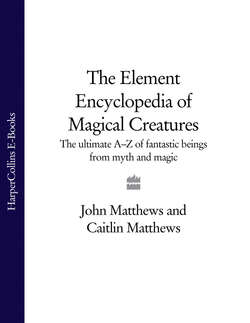Читать книгу The Element Encyclopedia of Magical Creatures: The Ultimate A–Z of Fantastic Beings from Myth and Magic - John Matthews - Страница 89
AMPHISBAENA
ОглавлениеThe classical Greek writer Lucan, who described the Amphisbaena as a winged reptile with an extra head on the end of its long prehensile tail, first mentions this creature in his book Pharsalia. The creature’s name means ‘to go both ways’. It became a favourite device of the compilers and embellishers of medieval bestiaries, who often showed this creature in the margins of their books. It is generally shown with its tail curved above its back, grasping its extra head in the jaws of its normal mouth. In this position, it was able to travel by rolling along the ground like a wheel. It must have been a formidable adversary to encounter, since it could run in either direction, possessed the legs of an eagle with claws to grip its victims, and eyes that gave forth beams of light in the darkness. Wounds inflicted by the Amphisbaena generally failed to heal and brought death to the person who had been bitten. Yet, despite its evil nature, it was much sought-after during the Middle Ages for its medical properties. According to Lucan and his fellow-writer Pliny the Elder, its dried skin was an excellent cure for rheumatism. It is described as living in the deserts of Libya and may possibly be based on an actual reptile that is capable of running in both directions, and that raises its tail like a scorpion when threatened. It appears among the great bestiary of creatures in European heraldry.
